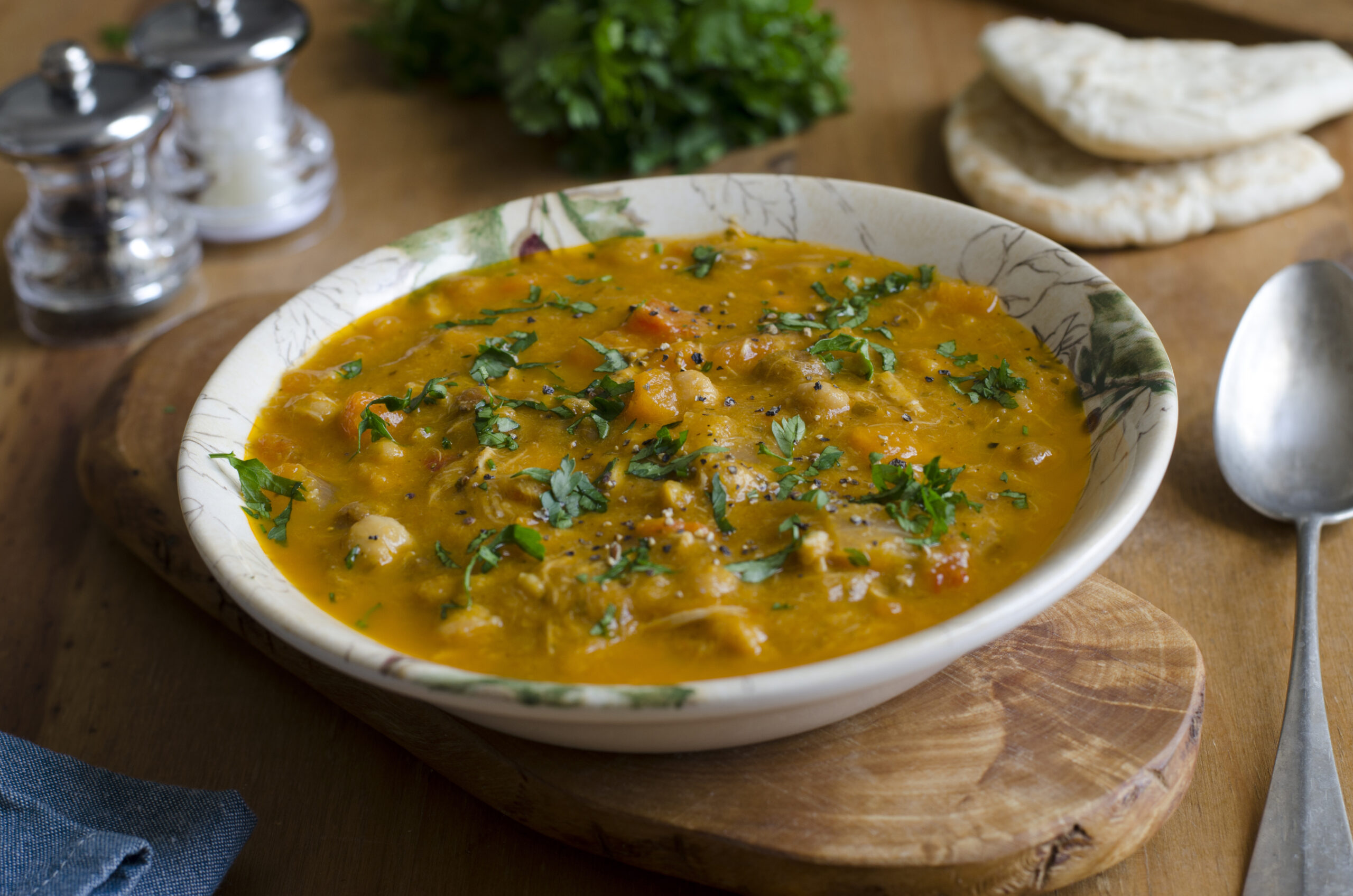
This easy to make late spring soup is delicious. Fill your kitchen with the aromas of fresh cilantro and garlic bread baking as the chickpeas and vegetables simmer. Yum!
Cilantro is a popular indian spice that is invaluable medicine too. It soothes an irritated digestive system and cools any burning sensations in the body. It’s sweet aroma can help lift the spirits and reduce depression. It is pungent, bitter and sweet and slightly oily and it reduces excess Vata and Pitta.
Cilantro also known as coriander is an excellent remedy for promoting digestion. Its especially good at building your metabolism without aggravating any acidity. It can be used safely when there is any inflammation in the digestive system and when the digestive fire needs strengthening.
It is a useful carminative herb prescribed for IBS and colic – both Vata-Pitta conditions. Both the leaf and the seed are used for digestion to clear gas, griping, and bloating.
It is also useful in the treatment of urinary tract infections such as cystitis, dysuria and cloudy urine. Its also a good remedy for diabetes and it helps reduce hot flashes.
It’s a great anti-allergenic remedy and helps with allergic rhinitis, and is especially good at clearing toxins from the skin. It has an antispasmodic effect in the lungs and acts as an expectorant to clear mucus from the lungs – great for Kaphas in spring.
Escarole is bitter and the bitter taste is said to overpower or correct all the other tastes. This makes the bitter taste one of our best sources of medicine. Bitter corrects the other tastes, for example, if you have been overindulging in sweets you may be feeling a bit heavy, dull and slow. You can take some bitter herbs instead to clean out.
Escarole is strongly anti-bacterial, anti-viral and anti-parasitical due to its strong drying effect. And bitter greens have the quality of reducing environmental toxins as well. The bitter taste “increases intelligence, ” and due to its clearing qualities, can help reduce brain fog – often experienced by Vatas.
Cilantro is very low in calories and contains no cholesterol. However, its deep-green leaves possess good amounts of antioxidants, essential oils, vitamins, and dietary fiber, which may help reduce LDL or “bad cholesterol” levels in the blood.
The leaves and stem tips are also rich in numerous anti-oxidant polyphenolic flavonoids. Cilantro is also a good source of minerals like potassium, calcium, manganese, iron, and magnesium. Potassium is an important component of cell and body fluids that help regulate heart rate and blood pressure. Iron is essential for red blood cell production. Manganese is used by the body as a co-factor for the antioxidant enzyme, superoxide dismutase.
It is also rich in many vital vitamins, including folic-acid, riboflavin, niacin, vitamin-A, beta carotene, vitamin-C, which are essential for optimum health. Vitamin-C is a powerful natural antioxidant. It provides about 225% of recommended daily intake. Vitamin-A, an important fat soluble vitamin and anti-oxidant, is also required for maintaining healthy mucusa and skin and is also essential for vision. Consumption of natural foods rich in vitamin-A and flavonoids (carotenes) may help protect from lung and oral cavity cancers.
Cilantro is one of the richest herbal sources for vitamin K which has a potential role in bone mass building through promotion of osteotrophic activity in the bones. It also has established role in the treatment of Alzheimer’s disease patients by limiting neuronal damage in their brain.
Cilantro leaves provide only 23 calories/100 g, but their phyto-nutrients profile is no less than any superfoods around us!
Escarole is a powerhouse of nutrition. Vatas often skip nutritious food due to constant snacking, so it’s important for Vatas to have nutritionally dense foods. Each 1-cup serving is rich in dietary fiber, vitamins, minerals and antioxidant compounds. To get the maximum health benefits, the Centers for Disease Control and Prevention advises eating dark, leafy green vegetables, such as escarole, regularly. A 2009 review of nutrition research published in “Nutrition Reviews” suggest that high inulin and fiber content in escarole help reduce glucose and LDL-cholesterol levels in diabetes and obese patients.
According to The American Institute for Cancer Research, dark green, leafy vegetables such as escarole contain a high concentration of a variety of carotenoid compounds. These act as antioxidants by inhibiting the ability of free radicals to damage DNA. Antioxidants help Vatas who tend to have low immunity, especially this time of year. These carotenoids help prevent the development of cancers like stomach, lung, colon, skin and breast cancer.
Soup Directions
There’s no one size fits all for what you should eat. If you would like to talk with me about what is the right diet for you, sign up for a complimentary consultation. Just click on the link to my online calendar to find a good time that works for you.
In Health,


The Holistic HIghway integrates traditional Western medical practices with Ayurveda medicine, creating a focus on prevention through nutrition, diet, and exercise; use of the latest genetic testing and other diagnostic techniques; and prescribed combinations of botanical medicines, supplements, therapeutic diets, detoxification programs, or stress-management techniques.

Integrative Health Expert | Ayurveda Practitioner | Author | Speaker
Kerry is a globally recognized leader in integrative medicine and the science of health known as Ayurveda. She is passionate about raising awareness of the need for a change in contemporary medicine that focuses on patient empowerment and a health-based (rather than disease-based) medical system.
Kerry is connected with The University of Pittsburgh Center for Integrative Medicine and remains a pioneer in the field of integrative medicine where she has developed a personalized system to manage chronic disorders by incorporating fundamental changes in diet, behavior, and stress while focusing on genetics.
This individualized program is so successful that many of her clients have achieved maximum healing and vitality after years of chronic problems!
More to Explore